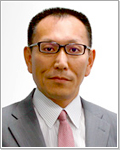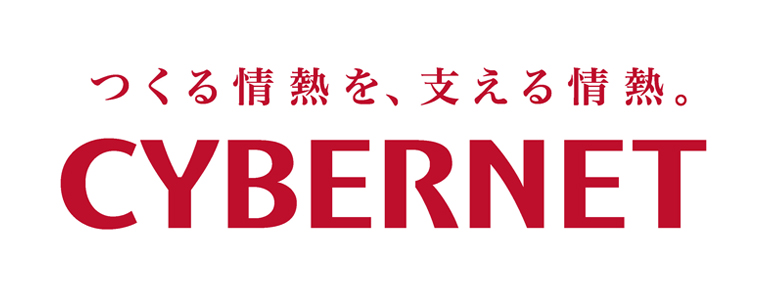| Cybernet Systems Co., Ltd. (4312) |
|
||||||||
Company |
Cybernet Systems Co., Ltd. |
||
Code No. |
4312 |
||
Exchange |
TSE 1st Section |
||
Industry |
Information and communications |
||
President & CEO |
Kuniaki Tanaka |
||
Address |
FUJISOFT Bldg. 3 Kanda-neribeicho, Chiyoda-ku, Tokyo |
||
Year-end |
December |
||
URL |
|||
*The share price is the closing price on August 17. The number of shares issued was calculated by subtracting the treasury shares from the number of outstanding shares at the end of the latest quarter. ROE and BPS are from the last year-end.
|
||||||||||||||||||||||||
|
|
This Bridge Report presents Cybernet Systems's first half of fiscal year December 2018 earnings results, and fiscal year December 2018 earnings estimates, etc. |
| Key Points |
 |
| Company Overview |
|
With "Computer Aided Engineering (CAE) Solution" and "IT Solution" as two pillars of the business, Cybernet supports the manufacturing of goods, "Monozukuri." CAE includes virtual designing and experimentation (simulation) on a computer. In the process of product development, CAE helps achieve high quality, shorten the development period, and reduce development cost. It is also environmentally friendly as it reduces waste materials generated by trial production. The Company is engaged in a license sales and maintenance service of more than 50 kinds of globally recognized software provided by more than 10 companies as well as an agency service to approximately 2,000 companies in the fields of automobiles, machinery, electric machinery and 500 research institutions and universities.
The Group is composed of the Company and its 13 consolidated subsidiaries. Its business is operated in North America, the UK, France, Germany, Belgium, and Asia. Among the main consolidated subsidiaries, there are 3 development subsidiaries: Sigmetrix, L.L.C. (US), which develops and sells tolerance analysis (the permissible range of variation in a dimension set at the time of design) software with technical support; Waterloo Maple Inc. (Canada) for formula manipulation systems; and Noesis Solutions NV (Belgium), which develops and sells the Process Integration and Design Optimization (PIDO) tools with technical support. The Group also has 3 distributor subsidiaries of CAE Solutions: CYBERNET SYSTEMS (SHANGHAI) CO., LTD. (Shanghai), CYBERNET SYSTEMS TAIWAN CO., LTD. (Taiwan, 57% ownership), and CYFEM Inc. (South Korea, 65% ownership).
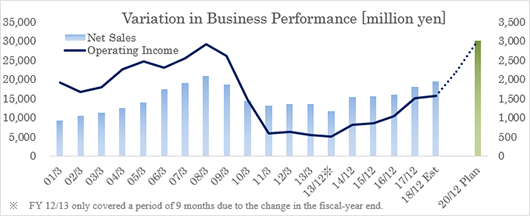 【Corporate Philosophy】
Cybernet's corporate philosophy is "We will contribute to the advancement of our customers and society by providing solutions that generate high satisfaction through enhanced value-added and high-quality services." With its corporate message of "Energy for your Innovation," Cybernet aims to become the "First Contact Company" for customers, that always walks with them and that they trust.
【Business Description】
Cybernet's business is divided into CAE Solution Services providing CAE solutions and related technical services, and IT Solution Services providing IT solutions and data solutions. CAE Solution Services account for over 80% of the entire business of the Group. 【Corporate Philosophy】
Cybernet's corporate philosophy is "We will contribute to the advancement of our customers and society by providing solutions that generate high satisfaction through enhanced value-added and high-quality services." With its corporate message of "Energy for your Innovation," Cybernet aims to become the "First Contact Company" for customers, that always walks with them and that they trust.
【Business Description】
Cybernet's business is divided into CAE Solution Services providing CAE solutions and related technical services, and IT Solution Services providing IT solutions and data solutions. CAE Solution Services account for over 80% of the entire business of the Group.
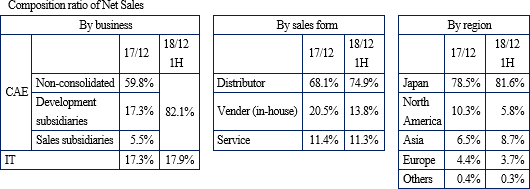 CAE Solution Services
In addition to Distributor Business and Vendor Business, both of which sell CAE software and hardware for analysis and simulation in conjunction with a Computer Aided Design (CAD) system, CAE Solution Services manage Consulting Business that provides solutions to respond to advanced demands from customers, design of electronic circuits and boards, model-based development (MDB, to be described later), engineering (consignment) services such as PIDO, and user education and support services such as holding seminars, user conferences, and case presentations.
6 CAE application areas and development/sales subsidiaries
The trend in this segment is described separately in the 6 application areas in which the Company (non-consolidated) utilizes CAE, as well as in development subsidiaries and sales subsidiaries.
6 CAE application areas:
(1) Mechanical CAE (MCAE)
After completing the designing process using CAD, it provides software and services that support analysis of structure, heat transfer, electromagnetic, and thermal fluid. The main product is the multiphysics (multiple physical forces) analysis tool "ANSYS," a product of ANSYS, Inc. (US)
(2) Optical Design
It provides optical analysis such as lens design, illumination analysis, optical communication system analysis and measurement tools related to organic EL and optical member characteristics, and solutions and services. Main products include "CODE V" (optical design evaluation program) and "LightTools" (analytical software for lighting design) manufactured by Synopsys, Inc. (US)
(3) Electronic Design Automation (EDA)
It provides software that automates electronic devices and semiconductors, and operation proposal/design analysis services in the process through design, analysis and manufacture/installation of a printed-circuit board (PCB). Main products include "Xpedition Enterprise" and "HyperLynx" manufactured by Mentor Graphics, Inc. (US)
(4) Model Based Development (MBD)
MBD is a design methodology that implements a development process of plan, design, and verification based on formula models. Major products are provided by Maplesoft, a subsidiary of the Group. The products include the STEM computing platform "Maple" and the system-level modeling and simulation tool "MapleSim."
(5) Test and Measurement, Others
In the area of test and measurement, the Company provides Flat Panel Display (FPD) Inspection System developed by the Company itself. In the area of others, it provides products of the Group: 3D tolerance management tools (optimization of cost and quality based on variation evaluation of sizes and sites of assembly parts) and optimized design support tools (analysis automation, robust control/reliability evaluation, application of quality engineering, etc.), as well as CAE technical education services.
Development subsidiaries
The 3 development subsidiaries are Sigmetrix, L.L.C. (US), which develops, sells and provides technical support for the 3D tolerance analysis software "CETOL 6σ;" Waterloo Maple Inc. (Canada), which develops, sells and provides technical support for the formula manipulation software "Maple" to formulate (visualize) various physical phenomena and 1D CAE software "MapleSim;" and Noesis Solutions NV (Belgium), which develops, sells and provides technical support for "Optimus id8" for Process Integration and Design Optimization (PIDO).
Sales subsidiaries
The 3 sales subsidiaries are CYBERNET SYSTEMS TAIWAN CO., LTD. (Taiwan), CYBERNET SYSTEMS (SHANGHAI) CO., LTD. (Shanghai) and CYFEM Inc. (Korea), of CAE Solutions.
IT Solution Services
IT Solution Services are composed of IT Solution Business and Data Solution Business. As for the IT Solution Business, the Company offers a wide range of solutions that support various companies' IT infrastructures including Symantec's endpoint security products that prevent computer virus infections and information leaks in the servers and client PCs, as well as "SKYSEA Client View" (SKY Inc.) and "ISM CloudOne" (Quality Software Inc.) designed for IT asset management solutions, database development support and application performance management.
Meanwhile, in the Data Solution Business, the Company offers digital solutions that support manufacturing of goods, including visualization solutions which visualize CAE analysis data plainly as well as AR (Augmented Reality)/VR (Virtual Reality), and big data. AR related solutions include AR application development tools and AR content distribution systems. VR related solutions include VR design review support systems and 3D application composite display software. The big data related solutions include the Company's original big data visualization tool "BIGDAT @ Viewer (big data viewer)."
In addition, the Company provides services such as operation consulting, introduction support, and user education support, according to the customers' environment. CAE Solution Services
In addition to Distributor Business and Vendor Business, both of which sell CAE software and hardware for analysis and simulation in conjunction with a Computer Aided Design (CAD) system, CAE Solution Services manage Consulting Business that provides solutions to respond to advanced demands from customers, design of electronic circuits and boards, model-based development (MDB, to be described later), engineering (consignment) services such as PIDO, and user education and support services such as holding seminars, user conferences, and case presentations.
6 CAE application areas and development/sales subsidiaries
The trend in this segment is described separately in the 6 application areas in which the Company (non-consolidated) utilizes CAE, as well as in development subsidiaries and sales subsidiaries.
6 CAE application areas:
(1) Mechanical CAE (MCAE)
After completing the designing process using CAD, it provides software and services that support analysis of structure, heat transfer, electromagnetic, and thermal fluid. The main product is the multiphysics (multiple physical forces) analysis tool "ANSYS," a product of ANSYS, Inc. (US)
(2) Optical Design
It provides optical analysis such as lens design, illumination analysis, optical communication system analysis and measurement tools related to organic EL and optical member characteristics, and solutions and services. Main products include "CODE V" (optical design evaluation program) and "LightTools" (analytical software for lighting design) manufactured by Synopsys, Inc. (US)
(3) Electronic Design Automation (EDA)
It provides software that automates electronic devices and semiconductors, and operation proposal/design analysis services in the process through design, analysis and manufacture/installation of a printed-circuit board (PCB). Main products include "Xpedition Enterprise" and "HyperLynx" manufactured by Mentor Graphics, Inc. (US)
(4) Model Based Development (MBD)
MBD is a design methodology that implements a development process of plan, design, and verification based on formula models. Major products are provided by Maplesoft, a subsidiary of the Group. The products include the STEM computing platform "Maple" and the system-level modeling and simulation tool "MapleSim."
(5) Test and Measurement, Others
In the area of test and measurement, the Company provides Flat Panel Display (FPD) Inspection System developed by the Company itself. In the area of others, it provides products of the Group: 3D tolerance management tools (optimization of cost and quality based on variation evaluation of sizes and sites of assembly parts) and optimized design support tools (analysis automation, robust control/reliability evaluation, application of quality engineering, etc.), as well as CAE technical education services.
Development subsidiaries
The 3 development subsidiaries are Sigmetrix, L.L.C. (US), which develops, sells and provides technical support for the 3D tolerance analysis software "CETOL 6σ;" Waterloo Maple Inc. (Canada), which develops, sells and provides technical support for the formula manipulation software "Maple" to formulate (visualize) various physical phenomena and 1D CAE software "MapleSim;" and Noesis Solutions NV (Belgium), which develops, sells and provides technical support for "Optimus id8" for Process Integration and Design Optimization (PIDO).
Sales subsidiaries
The 3 sales subsidiaries are CYBERNET SYSTEMS TAIWAN CO., LTD. (Taiwan), CYBERNET SYSTEMS (SHANGHAI) CO., LTD. (Shanghai) and CYFEM Inc. (Korea), of CAE Solutions.
IT Solution Services
IT Solution Services are composed of IT Solution Business and Data Solution Business. As for the IT Solution Business, the Company offers a wide range of solutions that support various companies' IT infrastructures including Symantec's endpoint security products that prevent computer virus infections and information leaks in the servers and client PCs, as well as "SKYSEA Client View" (SKY Inc.) and "ISM CloudOne" (Quality Software Inc.) designed for IT asset management solutions, database development support and application performance management.
Meanwhile, in the Data Solution Business, the Company offers digital solutions that support manufacturing of goods, including visualization solutions which visualize CAE analysis data plainly as well as AR (Augmented Reality)/VR (Virtual Reality), and big data. AR related solutions include AR application development tools and AR content distribution systems. VR related solutions include VR design review support systems and 3D application composite display software. The big data related solutions include the Company's original big data visualization tool "BIGDAT @ Viewer (big data viewer)."
In addition, the Company provides services such as operation consulting, introduction support, and user education support, according to the customers' environment.
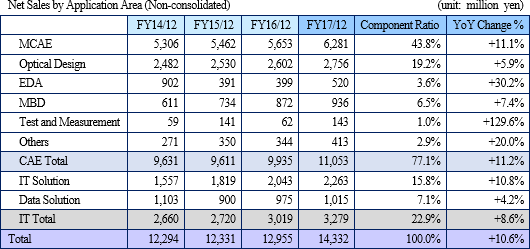 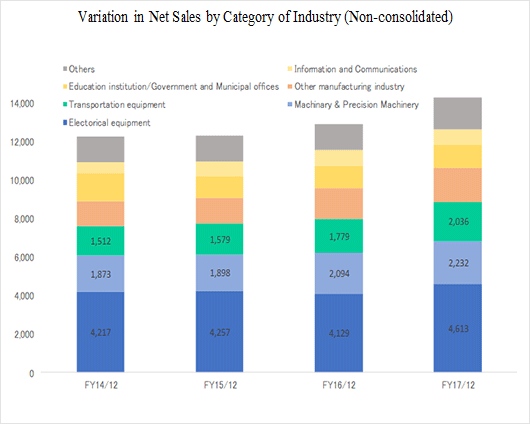 |
| First Half of Fiscal Year ending December 2018 Earnings Results |
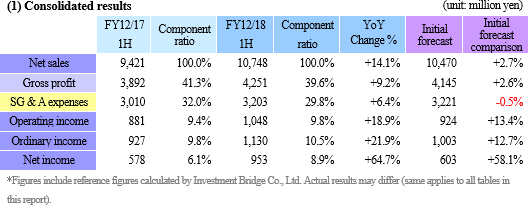 Sales increased 14.1% year on year, operating income up 18.9%
Sales were 10,748 million yen, up 14.1% year on year. There was a double digit increase in sales for both the IT and CAE solution services. The sales of CAE solution services rose 15.7%, due to the strong performance of the MCAE and optical design fields as well as the growth of MBD (Model Based Development). The sales of IT solution services grew 13.2%, thanks to an increase in the sale of licenses for security-related solutions.
Operating income was 1,048 million yen, up 18.9% year on year. Gross profit rate fell 1.7 points due to a rise in the sales composition ratio for products with relatively high cost rates, such as Symantec products and design platforms for automotive lighting (optical design field). SG&A expenses augmented due to the increase of staff and the subsequent rise in personnel expenses, as well as increased spending for research and development of new products, but this was offset by sales growth. Non-operating income/loss improved due to favorable foreign exchange gains and losses and an increase in subsidy revenue. In addition, 494 million yen gained on transfer of business was recorded as extraordinary income, and net income for the quarter grew 64.7% year on year to 953 million yen.
Operating income before the amortization of goodwill was 1,191 million yen (estimate: 1,060 million yen), an increase of 16.7% year on year. EBITDA rose 17.2% to 1,352 million yen (estimate: 1,214 million yen). The Company views these as important management indicators. Sales increased 14.1% year on year, operating income up 18.9%
Sales were 10,748 million yen, up 14.1% year on year. There was a double digit increase in sales for both the IT and CAE solution services. The sales of CAE solution services rose 15.7%, due to the strong performance of the MCAE and optical design fields as well as the growth of MBD (Model Based Development). The sales of IT solution services grew 13.2%, thanks to an increase in the sale of licenses for security-related solutions.
Operating income was 1,048 million yen, up 18.9% year on year. Gross profit rate fell 1.7 points due to a rise in the sales composition ratio for products with relatively high cost rates, such as Symantec products and design platforms for automotive lighting (optical design field). SG&A expenses augmented due to the increase of staff and the subsequent rise in personnel expenses, as well as increased spending for research and development of new products, but this was offset by sales growth. Non-operating income/loss improved due to favorable foreign exchange gains and losses and an increase in subsidy revenue. In addition, 494 million yen gained on transfer of business was recorded as extraordinary income, and net income for the quarter grew 64.7% year on year to 953 million yen.
Operating income before the amortization of goodwill was 1,191 million yen (estimate: 1,060 million yen), an increase of 16.7% year on year. EBITDA rose 17.2% to 1,352 million yen (estimate: 1,214 million yen). The Company views these as important management indicators.
 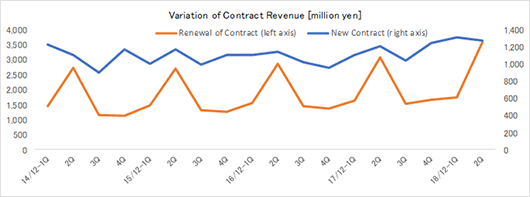 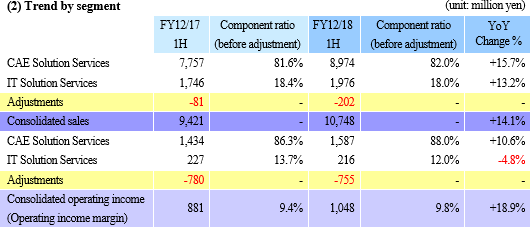 CAE solution service
Sales were 8,974 million yen, up 15.7% year on year, and operating income was 1,587 million yen, up 10.6% year on year. Profit rate declined due to the change in the product mix, but sales grew mainly in the fields of MCAE and optical design. The trend of each business domain is as follows.
In the MCAE field, the sales of licenses for the product (multiphysics analysis tool) of ANSYS, Inc. in the U.S., which is the mainstay, increased mainly in the fields of automobiles, machinery, and precision instruments, and a new package including optional functions also contributed to the healthy progress of renewal of maintenance contracts. The sales of the engineering service, too, grew thanks to the increase in demand for model reduction and analysis automation in the fields of automobiles and precision machinery.
In the field of optical design, proposal-based strategies including the support for operation and the establishment of a development environment were effective, and the sales of licenses for the platform for designing automotive lighting increased, as the Company received large-scale orders from automobile-related industries. On the other hand, the core product "CODE V" (a program for evaluating optical design) of Synopsys, Inc. in the U.S. saw the steady progress of renewal of maintenance contracts, but its license sales were unchanged from the same period of the previous term. "LightTools" (analytical software for lighting design) of Synopsys, Inc. in the U.S. saw the healthy progress of renewal of maintenance contracts, but its license sales declined.
In the field of EDA (Electronic Design Automation), the sales of the PCB (printed circuit board) engineering service grew mainly in the fields of machinery and precision instruments, but the electronic circuit board design solutions, such as "Xpedition Enterprise" and "HyperLynx" of Mentor Graphics, Inc. in the U.S., witnessed the decreases in the sales of licenses and the renewal of maintenance contracts, due to the sluggishness of the electrical equipment industry although the sales of semiconductor-related products increased.
In the field of MBD (Model Based Development), the sales of licenses of 1D CAE Tool, which is a product of the Group, increased mainly in the fields of machinery, precision instruments, and electrical equipment, due to the growth of needs for measures against the heat problem, and the renewal of maintenance contracts progressed. As for the engineering service of MBD, the Company received more inquiries related to EV, as there are an increasing number of inquiries about automated driving and MBSE from the automobile industry.
In the field of tests and measurement, the Company received orders for the system for automatically testing flat panel displays (FPDs), which was developed by the Company, as a pilot device for the electrical equipment industry, and also received orders for high-precision scattering measurement devices for measuring the parts of medical apparatus. In other fields, the renewal of maintenance contracts for the optimal design support tool and the three-dimensional tolerance management tool, which are both products of the Group, progressed, but the sales of licenses declined. CAE solution service
Sales were 8,974 million yen, up 15.7% year on year, and operating income was 1,587 million yen, up 10.6% year on year. Profit rate declined due to the change in the product mix, but sales grew mainly in the fields of MCAE and optical design. The trend of each business domain is as follows.
In the MCAE field, the sales of licenses for the product (multiphysics analysis tool) of ANSYS, Inc. in the U.S., which is the mainstay, increased mainly in the fields of automobiles, machinery, and precision instruments, and a new package including optional functions also contributed to the healthy progress of renewal of maintenance contracts. The sales of the engineering service, too, grew thanks to the increase in demand for model reduction and analysis automation in the fields of automobiles and precision machinery.
In the field of optical design, proposal-based strategies including the support for operation and the establishment of a development environment were effective, and the sales of licenses for the platform for designing automotive lighting increased, as the Company received large-scale orders from automobile-related industries. On the other hand, the core product "CODE V" (a program for evaluating optical design) of Synopsys, Inc. in the U.S. saw the steady progress of renewal of maintenance contracts, but its license sales were unchanged from the same period of the previous term. "LightTools" (analytical software for lighting design) of Synopsys, Inc. in the U.S. saw the healthy progress of renewal of maintenance contracts, but its license sales declined.
In the field of EDA (Electronic Design Automation), the sales of the PCB (printed circuit board) engineering service grew mainly in the fields of machinery and precision instruments, but the electronic circuit board design solutions, such as "Xpedition Enterprise" and "HyperLynx" of Mentor Graphics, Inc. in the U.S., witnessed the decreases in the sales of licenses and the renewal of maintenance contracts, due to the sluggishness of the electrical equipment industry although the sales of semiconductor-related products increased.
In the field of MBD (Model Based Development), the sales of licenses of 1D CAE Tool, which is a product of the Group, increased mainly in the fields of machinery, precision instruments, and electrical equipment, due to the growth of needs for measures against the heat problem, and the renewal of maintenance contracts progressed. As for the engineering service of MBD, the Company received more inquiries related to EV, as there are an increasing number of inquiries about automated driving and MBSE from the automobile industry.
In the field of tests and measurement, the Company received orders for the system for automatically testing flat panel displays (FPDs), which was developed by the Company, as a pilot device for the electrical equipment industry, and also received orders for high-precision scattering measurement devices for measuring the parts of medical apparatus. In other fields, the renewal of maintenance contracts for the optimal design support tool and the three-dimensional tolerance management tool, which are both products of the Group, progressed, but the sales of licenses declined.
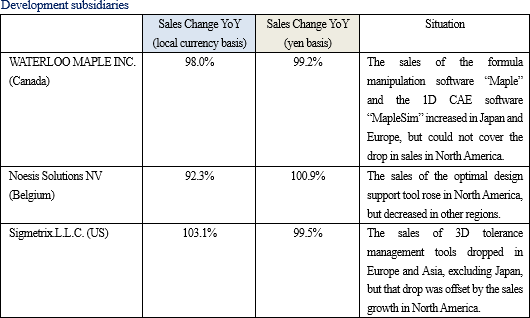 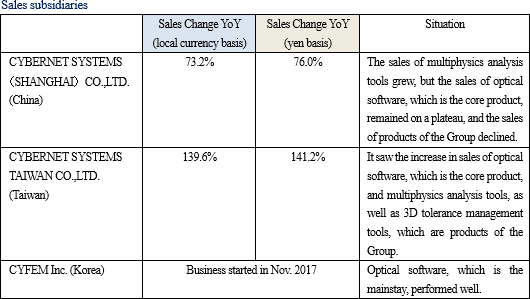 IT solution service
Sales were 1,976 million yen, up 13.2% year on year, and operating income was 216 million yen, down 4.8% year on year. Operating income decreased, because sales growth was seen mainly for products with a high cost rate, including the products of Symantec. The trend of each business domain is as follows.
In the field of IT solutions, the license sales of security-related solutions, such as the products of Symantec, increased, because the Company received large-scale orders for the industry of information and communications (monthly charging license model), and the renewal of maintenance contracts progressed. In addition, the license sales of solutions for IT asset management, database development support, application performance management, etc., including "SKYSEA Client View" (SKY Inc.) and "ISM CloudOne" (Quality Software Inc.), increased, as the Company received large-scale orders from the transportation equipment industry. In addition, the renewal of maintenance contracts progressed.
In the data solution field, the sales in the AR and VR fields increased, as the Company received orders for virtual design review for VR products and the service of undertaking the development of task support systems using MR devices, etc., but the license sales of innovation support solutions declined (while the renewal of maintenance contracts progressed). The sales of medical visualization engineering declined, due to the recoil from the large-scale orders from educational institutions and public offices in the same period of the previous term. IT solution service
Sales were 1,976 million yen, up 13.2% year on year, and operating income was 216 million yen, down 4.8% year on year. Operating income decreased, because sales growth was seen mainly for products with a high cost rate, including the products of Symantec. The trend of each business domain is as follows.
In the field of IT solutions, the license sales of security-related solutions, such as the products of Symantec, increased, because the Company received large-scale orders for the industry of information and communications (monthly charging license model), and the renewal of maintenance contracts progressed. In addition, the license sales of solutions for IT asset management, database development support, application performance management, etc., including "SKYSEA Client View" (SKY Inc.) and "ISM CloudOne" (Quality Software Inc.), increased, as the Company received large-scale orders from the transportation equipment industry. In addition, the renewal of maintenance contracts progressed.
In the data solution field, the sales in the AR and VR fields increased, as the Company received orders for virtual design review for VR products and the service of undertaking the development of task support systems using MR devices, etc., but the license sales of innovation support solutions declined (while the renewal of maintenance contracts progressed). The sales of medical visualization engineering declined, due to the recoil from the large-scale orders from educational institutions and public offices in the same period of the previous term.
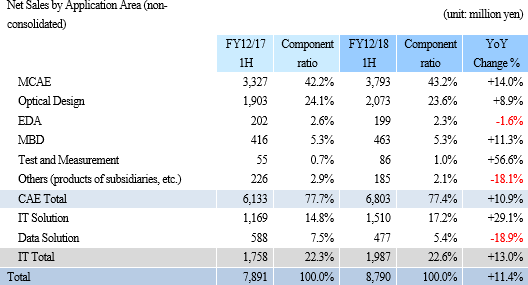 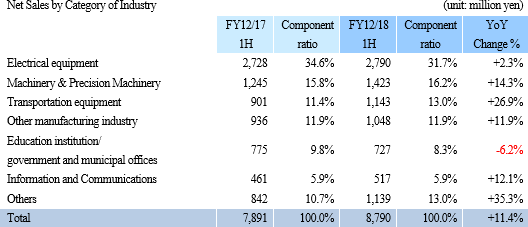 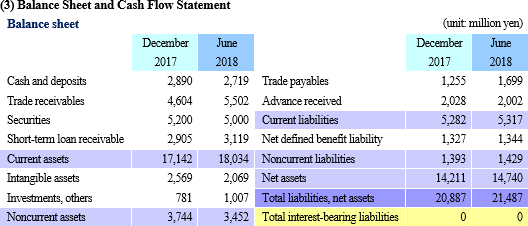 Total assets at the end of the first half were 21,408 million yen, up 599 million yen from the end of the previous term. Due to increased sales, there was a rise in accounts payable and trade receivables. Net assets increased, reflecting favorable business performance. Meanwhile, goodwill was affected by amortization and exchange rates, and fell 269 million yen (of which 125 million yen was due to foreign exchange). Capital-to-asset ratio was 68.0% (67.6% at the end of the previous term).
Total assets at the end of the first half were 21,408 million yen, up 599 million yen from the end of the previous term. Due to increased sales, there was a rise in accounts payable and trade receivables. Net assets increased, reflecting favorable business performance. Meanwhile, goodwill was affected by amortization and exchange rates, and fell 269 million yen (of which 125 million yen was due to foreign exchange). Capital-to-asset ratio was 68.0% (67.6% at the end of the previous term).
 The decrease in operating CF is due to an increase in trade receivables. Loans increased under investing CF, and financing CF declined due to payment of dividends.
The decrease in operating CF is due to an increase in trade receivables. Loans increased under investing CF, and financing CF declined due to payment of dividends.
|
| Fiscal Year Ending December 2018 Earnings Estimates |
 There is no change in the full-year forecast. Sales and operating income are expected to rise 8.5% and 3.7%, respectively.
FY 2018 is positioned as the "period of upfront investment" and the Company will work towards completing the medium-term management plan by focusing on investment in human resources, improving the Group's products, and developing new products. It is estimated that there will be an increase in personnel expenses (roughly 20 additional staff members inside and outside Japan) and development expenses (over 100 million yen increase), as well as another 100 million yen or more to be spent for upgrading the core system (ERP).
Sales estimates are conservative, because the higher-than-expected OEM sales in the fourth quarter of the previous term were due to a contract that was originally scheduled for the current term but was moved up due to circumstances on the client's end. In addition, the Company's performance tends to be weighted in the first half, as sales are usually weaker in the third quarter (July-September).
The Company will pay interim and term-end dividends of 8.26 yen/share each, for a total annual dividend of 16.52 yen/share, an increase of 1.47 yen/share. The payout ratio is 50%.
The Company's basic policy for distributing profits includes determining dividends by using a payout ratio of 50% or a net asset (shareholders' equity) dividend rate of 3.0%, whichever is higher. In order to make well-rounded decisions, they also take into consideration the amount invested into raising corporate value over the medium-and long-term. There is no change in the full-year forecast. Sales and operating income are expected to rise 8.5% and 3.7%, respectively.
FY 2018 is positioned as the "period of upfront investment" and the Company will work towards completing the medium-term management plan by focusing on investment in human resources, improving the Group's products, and developing new products. It is estimated that there will be an increase in personnel expenses (roughly 20 additional staff members inside and outside Japan) and development expenses (over 100 million yen increase), as well as another 100 million yen or more to be spent for upgrading the core system (ERP).
Sales estimates are conservative, because the higher-than-expected OEM sales in the fourth quarter of the previous term were due to a contract that was originally scheduled for the current term but was moved up due to circumstances on the client's end. In addition, the Company's performance tends to be weighted in the first half, as sales are usually weaker in the third quarter (July-September).
The Company will pay interim and term-end dividends of 8.26 yen/share each, for a total annual dividend of 16.52 yen/share, an increase of 1.47 yen/share. The payout ratio is 50%.
The Company's basic policy for distributing profits includes determining dividends by using a payout ratio of 50% or a net asset (shareholders' equity) dividend rate of 3.0%, whichever is higher. In order to make well-rounded decisions, they also take into consideration the amount invested into raising corporate value over the medium-and long-term.
|
| the Medium-Term Business Plan (2015 to 2020) |
|
The Company is currently implementing the medium-term business plan, which is a six-year period plan from 2015 to 2020 (first phase: 2015 to 2017, second phase: 2018 to 2020). The medium-term business plan is based on these basic strategies: "Provide value unique to Cybernet," "Focus on automotive field," and "Strengthen cooperation with partners." Target figures for the final FY2020 are consolidated net sales of 30 billion yen (15.39 billion yen in 2014) and consolidated operating income of 3 billion yen.
The company achieved over 8.0% of consolidated operating income ratio in the first phase of the plan ended in FY 2017. For the basic strategy "Provide value unique to Cybernet," the domestic sales of Multi-domain Solutions (to be explained later) development on which the company focused grew from 12.7 billion yen in FY2014 to 14.6 billion yen in FY2017. With regard to "Focus on automotive field," rate of sales in the automobile-related field in the domestic sales grew from 12.0% in FY2014 to 16.4% in FY 2017. As for "Strengthen cooperation with partners" aiming at the expansion of the Vendor Business, the number of sales partners increased from 81 to 123 companies (increased by 52%) and OEM sales towards partners increased from 450 million yen to 550 million yen (increased by 23%) (since OEM sales are almost equal to the operating income, their impact in terms of profit is huge).
【Second phase (2018 to 2020) - Rise of the top line accompanied by improvement of profitability- 】
The Company is aiming at double-digit growth and an operating income margin of 10% for the Distributor Business and Consulting Business and double-digit growth and an operating income margin of 20% for the Vender Business. In addition to expansion of existing businesses and new businesses that began in the first phase (2015 to 2017), the Company anticipates contributions from new businesses that will be launched in the second phase (2018 to 2020). With respect to the existing businesses, the Company will grow from 17.3 billion yen in FY 2017 to 22.6 billion yen (average growth rate of 9.4%). With respect to the new businesses that began in the first phase, it will increase "1D CAE + 3D CAE Multi-domain Solutions," etc. from 0.7 billion yen to 3.4 billion yen. As for the businesses that will be launched in the second phase, it will grow the "Extended Multi-domain Solutions by MBSE (to be described later)" to the scale of 3.9 billion yen.
Basic strategies
To offer value unique to Cybernet
In the second phase of the medium-term business plan, the Company will continue to promote "1DCAE + 3DCAE Multi-domain Solutions," which are becoming increasingly popular, and will expand "Extended Multi-domain Solutions by MBSE" to contribute to improve development efficiency. MBSE is a development method to manage the entire development process on a formula model basis across multiple disciplines. With "Extended Multi-domain Solutions by MBSE," the Company will be able to build a solution that will cover the entire process from 0D, the preliminary stage of 1D, to validation. The Company's strengths are, in addition to the technology of its subsidiaries, years of technical support and consulting experiences of CAE and MDB. In the long term, it plans to build MBSE platforms and initiate a platform business. Regarding technologies that are insufficient to build the MBSE platforms, it is intending to establish partnerships or implement M&A using surplus funds of about 10 billion yen.
Focus on automotive field
In the field of automobiles in which development of Advanced Driver-Assistance Systems (ADAS), EV, and Connected Car is advancing, technical challenges are welcomed. For this reason, the Company will provide solutions in various technical fields. Specifically, the fields include sensors, controllers, structural function design, and information/communications. Especially in the sensor field, development of fusion sensors that combine functions of multiple sensors has also begun. As the number of sensors in vehicles increases, the car safety will improve. However, the number of sensors that can be installed is restricted within a limited automobile space. For this reason, fusion sensors are attracting attention, and "Extended Multi-domain Solutions by MBSE" is indispensable for shortening development time and reducing development cost. The Company will also focus on proposing "Optimus id8," optimized design support software that automates and integrates the analysis process in each field in order to effectively utilize internal resources and shorten the development period.
Strengthen cooperation with partners
The Company will work on building sales and support systems globally and locally and promote OEM. Specifically, it will build a global agency network in North America, Europe and Asia to expand the subsidiaries' businesses and build a domestic agency network to increase sales of new products in Japan. It will also work on strengthening partnerships with overseas consulting companies that have expertise in CAE solutions.
Meanwhile, as for OEM, although it had been focusing on OEMs targeting the companies in the same industry, it will also put emphasis on the end-users by expanding OEM to the field of IoT (Digital Twin). More and more manufacturers are seeking profit-making opportunities not only in sales of their products but also in a maintenance and follow-up service, which leads to a possibility that CAE can be used for both development and maintenance. As part of this, the Company is focusing on the Digital Twin field. Digital Twin creates a platform using IoT and CAE, and analyzes causes of failure and malfunction in advance. Digital Twin is a concept or system that reproduces physical events into a digital field and predicts and analyzes causes of failure and malfunction in advance. Preliminary analysis of causes of failure or malfunction using IoT predicts occurrence of faults and malfunctions based on sensor information. In parallel with this, Digital Twin reproduces the same environment as the actual usage situation on a computer and carries out preliminary analysis of the causes of failure or malfunction.
Strategies by Business Domain, Global Strategies and Strategies by Application Area
Under the basic strategies, the Company will implement the Strategies by Business Domain, Global Strategies and Strategies by Application Area.
Strategies by Business Domain
The Company will increase the highly profitable Vendor Business and Consulting. As for the Distributor Business, it will improve sales by its expanding sales territory while reducing the sales component ratio. It will increase the sales component ratio of the Vender Business and Consulting, which accounted for 32 % (5.8 billion yen) in FY 2017 to 36% (10.8 billion yen) in FY2020 and reduce the component ratio of the Distributor Business from 68% (12.2 billion yen) to 64% (19.2 billion yen). In the Distributor Business, it will strengthen its relationship with vendors, pursue added value by Multi-domain Solutions and technical support, and expand its sales territory.
For the Distributor Business, it will focus on Asia where there is much room for business expansion. In terms of market, it will focus on the automotive field where demand for ADAS, EV, and Connected Car can be expected and IoT field including Digital Twin(※1). It is intending to differentiate itself through development of MBSE.
※1 Digital Twin:Reproduces physical events into a digital field and predicts and analyzes causes of failure and malfunction in advance
Global Strategies
While expanding business in Japan, the Company will work to increase the ratio of overseas sales. the Company will expand the businesses from 10% (1.8 billion yen) to 14% (4.2 billion yen) in North America, from 4% (700 million yen) to 6% (1.8 billion yen) in Europe, from 7% (1.3 billion yen) to 11% (3.3 billion yen) in Asia. The CAE market share by region is 40% in North America, 30% in Europe and 30% in Asia including Japan, and in the case of the Company, there is large room for overseas business expansion.
The Company will acquire sales agency rights and develop the Distributor Business by expanding its sales territory to Asia, ASEAN and India. In North America and Europe, it will cultivate local sales partners or strengthen partnerships with consulting companies through alliances and capital tie-ups, and expand subsidiary products with a focus on OEM. In Europe, it will especially focus on the German market. Meanwhile, in Japan, it will make efforts to provide products of the subsidiaries using OEM and promote the MBSE business by strengthening collaboration among the Group companies. It will also strengthen collaboration between CAE Solution and IT Solution (security, asset management, big data visualization, etc.).
Strategies for Application Area
The Company will expand CAE solution sales from 14.6 billion yen in FY 2017 to 24.5 billion yen in FY 2020. For MCAE, the Company's mainstay area, it will work to increase its sales from 6.5 billion yen to 9.5 billion yen. It will work to expand the products of ANSYS in Asia by strengthening cooperation with the sales subsidiaries in China and Taiwan. It will also strengthen sales of mechanism analysis software (analyzing motions) which it began handling in January 2018. Because the Company can work closely with the ANSYS products for the mechanism analysis software to analyze movement, it will develop mechanism analysis solutions targeting the users of the ANSYS products. For optical design, in order to increase its sales from 3.4 billion yen to 5.2 billion yen, it will try to expand into the automobile field (analysis solutions for head lights) that the Company entered full-scale in the first phase of the medium-term business plan. They will also work to increase EDA sales from 500 million yen to 900 million yen by promoting customers to replace their competitors' products with their products. For MBD, it will expand its sales from 3.1 billion yen to 6.0 billion yen. it will promote OEM development of the model-based analysis software "1D CAE tool" in North America and Europe. Furthermore, it will develop MBSE solutions targeting automobile-related field in Japan. In other fields, the company will expand the sales from 1.1 billion yen to 2.9 billion yen. The 3D tolerance analysis software "CETOL 6σ" handled by its subsidiary Sigmetrix (US) will grow. It is a favorable factor that this software program became compatible with all 3 major CADs in the world in the second phase of 2017. The 3 major CADs in the world are "CATIA" of Dassault Systemes (France), "Creo Parametric" of PTC (US) and "NX" of Siemens AG (Germany). Until that time, "CETOL 6σ" had not been supporting "NX" of Siemens AG (Germany). With this effect, the sales of Sigmetrix in FY 2017 grew 30% YoY and the operating income margin exceeded 20%.
The Company will expand IT solution sales from 3.4 billion yen in FY 2017 to 5.5 billion yen in FY 2020. In IT Solution Services, in addition to the existing 3-pillar strategies based on "security, IT asset management, and cloud solution," the Company will provide CAE software on a cloud-basis. Currently, provision of CAE software on a cloud-basis is not common, but the Company believes that it will become popular in the future.
In Data Solution, it will promote the Medical Visualization Business as a new business in addition to strengthening the on-going project to link AR (Augmented Reality), VR (Virtual Reality) and big data with CAE. The Medical Visualization Business is a national project in collaboration with Olympus, Showa University School of Medicine and Nagoya University, which oversees AI, and it is developing the image processing software for colonoscopy. (It is aiming at commercialization in 2020).
|
| Conclusions |
|
The progress rate is steady in terms of the full-year forecast. The progress rate of sales is 55.1% (52.4% in the same period of the previous term), that of operating income is 67.1% (58.6%), that of ordinary income is 66.1% (56.6%), and that of net income is 92.6% (61.7%). The reason why the forecast remains the same is because in the second quarter (April-June), there were slightly fewer new contracts for CAE than there were in the previous term. In addition, the Company anticipates that major business negotiations at overseas subsidiaries in the fourth quarter will have a large impact on profit. However, considering the widespread use and expansion of automotive electronics, electric cars, and IoT, the CAE market is expected to grow. Technological innovation is ongoing, which can be seen in CAE itself, as well as MBD, MBSE, and Digital Twin. For this reason, it is more important to determine whether or not the Company is on the right track in terms of market growth rather than focusing on performance in the immediate future. We would like to pay attention to progress regarding the Company’s global strategy and their strategies for each applied field and business domain.
|
| <Reference: Regarding Corporate Governance> |
 Basic Policy
Our company will thoroughly observe all applicable laws and regulations in all corporate activities and take actions that conform to social ethics as we have set forth in the "Cybernet Group Compliance Policy Guidelines" (hereinafter referred to as "Cybernet Policy Guidelines"). This is our basic attitude towards all shareholders. In addition, we respect the Cybernet Policy Guidelines as our company's basic policy in regard to corporate governance and we strive to ensure the soundness of our management, clarify accountability, and disclose impartial and timely information. We are also aiming to expedite management decisions and improve supervisory functions of business execution, as well as endeavoring to create organizations with effective risk management and screening functions.
<Reasons for Non-Compliance with the Principles of the Corporate Governance Code (Excerpts)>
We have implemented all the principles of corporate governance code.
<Disclosure Based on the Principles of the Corporate Governance Code (Excerpts)>
Principle 1-4 "Strategically-held shares"
As a general rule, our company does not hold listed stocks as "strategically-held shares." However, in the event of holding for business partnerships or other logical business reasons, we verify that the holding is for a goal related purpose and regularly confirm the rationality of it.
Principle 1-7 Transactions between related parties
Regarding important transactions with related parties, the board of directors makes decisions after sufficient deliberation concerning the rationality and validity of the transaction details. Also, as necessary, the legal department will conduct a review based on the opinions of external experts. Furthermore, for transactions with controlling shareholders, please refer to "I. 4. Guidelines on Measures to Protect Minority Shareholders in Transactions with Controlling Shareholders."
Principle 5-1 Policy on constructive interaction with shareholders
The Company has established a department in charge of IR, and the director in charge of that department is working as the director in charge of the administrative department to design an organic collaboration within the administration department. In addition, the department will report IR activity to the representative director or director in charge once a quarter. Furthermore, regarding the management of insider information, please refer to the following "V.2 (3) Disclosure Policy" and the "Information Disclosure Standard (Disclosure Policy)" listed on our website via the URL below.
(Information Disclosure Standard (Disclosure Policy))
http://www.cybernet.jp/ir/ir_policy/standard/
The Company's main IR activities are as follows:
(1) Financial results briefing (once a year)
(2) Medium-Term Business Plan briefing (once a year)
(3) General shareholders meeting (once a year)
(4) Briefing for individual investors (irregular)
(5) Personal meetings for institutional investors
(6) Information provision by e-mail
Basic Policy
Our company will thoroughly observe all applicable laws and regulations in all corporate activities and take actions that conform to social ethics as we have set forth in the "Cybernet Group Compliance Policy Guidelines" (hereinafter referred to as "Cybernet Policy Guidelines"). This is our basic attitude towards all shareholders. In addition, we respect the Cybernet Policy Guidelines as our company's basic policy in regard to corporate governance and we strive to ensure the soundness of our management, clarify accountability, and disclose impartial and timely information. We are also aiming to expedite management decisions and improve supervisory functions of business execution, as well as endeavoring to create organizations with effective risk management and screening functions.
<Reasons for Non-Compliance with the Principles of the Corporate Governance Code (Excerpts)>
We have implemented all the principles of corporate governance code.
<Disclosure Based on the Principles of the Corporate Governance Code (Excerpts)>
Principle 1-4 "Strategically-held shares"
As a general rule, our company does not hold listed stocks as "strategically-held shares." However, in the event of holding for business partnerships or other logical business reasons, we verify that the holding is for a goal related purpose and regularly confirm the rationality of it.
Principle 1-7 Transactions between related parties
Regarding important transactions with related parties, the board of directors makes decisions after sufficient deliberation concerning the rationality and validity of the transaction details. Also, as necessary, the legal department will conduct a review based on the opinions of external experts. Furthermore, for transactions with controlling shareholders, please refer to "I. 4. Guidelines on Measures to Protect Minority Shareholders in Transactions with Controlling Shareholders."
Principle 5-1 Policy on constructive interaction with shareholders
The Company has established a department in charge of IR, and the director in charge of that department is working as the director in charge of the administrative department to design an organic collaboration within the administration department. In addition, the department will report IR activity to the representative director or director in charge once a quarter. Furthermore, regarding the management of insider information, please refer to the following "V.2 (3) Disclosure Policy" and the "Information Disclosure Standard (Disclosure Policy)" listed on our website via the URL below.
(Information Disclosure Standard (Disclosure Policy))
http://www.cybernet.jp/ir/ir_policy/standard/
The Company's main IR activities are as follows:
(1) Financial results briefing (once a year)
(2) Medium-Term Business Plan briefing (once a year)
(3) General shareholders meeting (once a year)
(4) Briefing for individual investors (irregular)
(5) Personal meetings for institutional investors
(6) Information provision by e-mail
Disclaimer
This report is intended solely for information purposes, and is not intended as a solicitation for investment. The information and opinions contained within this report are made by our company based on data made publicly available, and the information within this report comes from sources that we judge to be reliable. However, we cannot wholly guarantee the accuracy or completeness of the data. This report is not a guarantee of the accuracy, completeness or validity of said information and opinions, nor do we bear any responsibility for the same. All rights pertaining to this report belong to Investment Bridge Co., Ltd., which may change the contents thereof at any time without prior notice. All investment decisions are the responsibility of the individual and should be made only after proper consideration.Copyright(C) 2018 Investment Bridge Co., Ltd. All Rights Reserved. |

